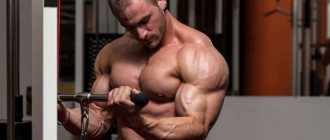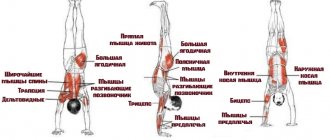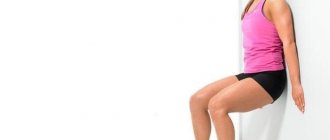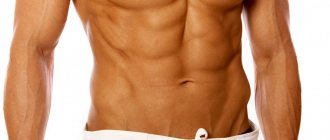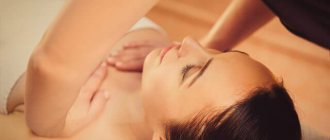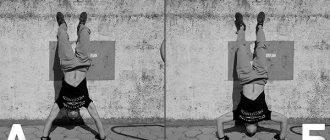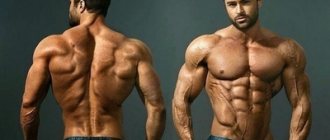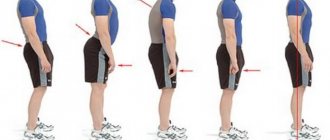From plastic pipes
You can make not exactly rings, but projectiles with which you can completely practice, just like with rings.
Take two cables, two carabiners (at least 100 kilograms each), a piece of pipe 5 centimeters in diameter and 10 centimeters long (two pieces, wrap with electrical tape to prevent your hands from slipping), two chains 30 centimeters long.
The cables need to be thrown over a tree branch so that there is a distance of about half a meter between them. Wrap the cable three times so that it does not wobble; the ends should hang 40 centimeters above your raised arms. We attach carabiners to the ends of the cables, and to them we attach a chain passed through plastic tubes. These rings are quite easy to make and you can do the same exercises with them as with professional equipment.
Just pay special attention to the strength of the structure; it must be injury-proof.
Made of wood
Wooden gymnastic rings, when manufactured correctly, will be no worse than professional ones, if you approach the technology correctly. Since the rings experience heavy loads during exercise, a regular board will not work, as it will quickly split into fibers, and it’s good if there is no injury.
The projectile requires plywood. Since gymnastic rings must have an internal diameter of 180 millimeters, and the diameter of the handle must be 30 millimeters, the plywood sheet must be selected accordingly. You won’t find plywood of such thickness, so you need to cut squares with a side of 270 millimeters and glue them together so that the final thickness of the workpiece exceeds 30 millimeters.
You need to take either a special carpenter's glue or a universal one, but not a glue glue, but one with a long drying period, for example Moment, then the workpieces will stick together firmly and for a long time. The glued plywood sheets must be kept under pressure; you can place a weight or any other suitable size object. You can even place it under the foot of a bed or cabinet, if possible (after placing a gasket so as not to damage the surface).
On the glued sheet we use compasses to mark the circles along which we will cut the rings - the internal diameter should be 180 millimeters, and the external one should not be 30 millimeters, but be equal to the thickness of the glued sheet, so that the cut circle is square in cross-section.
Using a drill, we drill holes for the jigsaw and cut along the marked circle. Next, we secure the workpiece in a vice, take a rasp and smooth out the corners, thus forming regular rings. Then we work with sandpaper and polish with fine sandpaper. Take a closer look to make sure there are no rolling pins or irregularities, since what is not very noticeable to the eye will be felt by your hands. These rings are strong and light.
For a child
If your child wants to practice on gymnastic rings, they can be made and secured at home. If you have a home horizontal bar, you can attach it to it. But a door frame or ceiling is quite suitable, it depends on the capabilities and skills of a caring dad.
You can use an expander on springs as handles, or take something similar. It is better that future gymnastic rings have a square section, as paradoxical as it sounds, it is more comfortable for the child to hold on to and the hands do not slip. The benefits of the expander are the handles of the expander, which are ergonomic and durable; the comfortable shape and strength will reduce the likelihood of injury.
We wrap the handles well with a rope (clothes rope will do) and tighten them with a self-tightening knot with a safety knot at the end of the rope. You need to place a mattress or at least a blanket under children's gymnastic rings to make the landing softer and allow you to safely do various strengthening exercises. Although children use such equipment simply for skating. Take this into account and take care of reliable fastenings, since falling from acceleration can be very painful. And if you ride on your hands, you can also develop certain muscles well in order to avoid injuries, children should. Gymnastic exercises make children flexible, resilient and strong.
Children's gymnastic rings
Many parents are interested in what age a child can play sports equipment, and how beneficial it is for healthy physical development. Since training on rings is a type of strength training and is quite similar to the use of parallel bars and a horizontal bar, children can be introduced to them from a very early age.
The advantage of rings for children is as follows:
- Unlike the same horizontal bars, the projectile is unstable. Accordingly, physical development occurs faster.
- Ring training is particularly varied, which prevents children from getting bored. This point becomes extremely important in cases where it is necessary to interest the baby in monotonous training.
DIY gymnastic rings
For home training, it is absolutely not necessary to purchase ready-made, expensive equipment. If you have a strong desire, tools and materials, you can make quite effective rings with your own hands.
The main thing when assembling a projectile is not so much a strong suspension as the presence of a reliable mount on which the structure will be placed. Alternatively, you can hang the rings on a thick tree branch, securing them to a good rope. It is desirable that such a crossbar be straight, parallel to the ground and support the weight of each family member who plans to use the device.
Self-assembly of gymnastic rings involves performing work in several successive stages:
- The ropes are thrown over the branch and wrapped around several times. The hangers should be placed at a distance of approximately 50 cm from each other.
- Carabiners are attached to the ends, which must be designed for a certain weight with some margin.
- Wooden or plastic rings are wrapped with fabric tape, which reduces the sliding effect.
- The rings are connected to the carabiners using chains.
Unfortunately, not each of us has the opportunity to buy ready-made gymnastic rings. Therefore, assembling them at home from scrap materials looks like an excellent option for organizing regular strength training.
Wood or plastic
Initially, wooden gymnastic rings were used. However, due to the growing popularity of fitness classes, lightweight plastic models have become widespread.
In fact, there are no defining differences between the specified materials of manufacture. However, there are still some features that deserve attention.
The sensations that the athlete experiences during training come first. The surface of the plastic is rough, which increases grip when in contact with the hands. In contrast, wooden products contain a smooth varnish finish. Both specifications are considered by individual athletes to be both advantages and disadvantages. It all depends on personal goals and needs.
If plastic rings have a perfect circle, then a wooden projectile has an oval shape. This difference affects the comfort of grip when performing certain exercises.
GYMNASTIC RINGS made of high quality wood
We present to your attention wooden gymnastic rings from. The rings are designed for strength training and development of movement coordination. This equipment can be used both for professional training and for sports at home
The latter is very important for children, for whom an early start to training is useful and productive.
This is why gymnastic rings are so popular and loved by both professional athletes and boys of any kind.
Briefly about the projectile Sports rings from are a projectile in the form of a pair of wooden rings that are attached to durable hangers. Our company makes rings exclusively from wood, not plastic. This allows us to say that they are durable, environmentally friendly, last a long time and have an attractive classic appearance. The rings are attached at the desired height using cables; the kit also has strong and reliable fastenings. The slings are made of reliable synthetic material, and the locks are made of steel. Therefore, for our gymnastic rings we allow super-heavy weights up to 250 kg.
What exercises are performed on rings? Exercises are usually performed on gymnastic rings, which are the same for both professional athletes and ordinary people who are concerned about maintaining health and good physical shape. So, on the rings they perform: • emphasis on the hands; • lifting; • rotation; • swing elements; • twisting.
Rings allow you to use both dynamic exercises and static exercises. Moreover, the former are less difficult than the latter, since static exercises give a greater load.
Equipment for everyone The above exercises are part of the mandatory exercises of the Olympic Games and Championships program. However, the value of the rings is not only that they are used for professional sports, but also that the rings can be used for sports activities and even games, including with children and teenagers. Because the earlier a child starts, the sooner he comes to gymnastics and gives better results. An early start is also good for yard activities not related to professional training. After all, this equipment allows you to train endurance, strength and the ability to maintain balance - gymnastic rings are characterized by the lack of stable points of support, and therefore an early start to training with rings will allow the child to learn to maintain balance and control his body.
The benefits of MONKO rings We recommend purchasing training rings from not only for organizing the training process in gyms. We also advise you to buy rings for outdoor activities and hang them at home. They are especially good if the family has a child of 3 years or more. As mentioned above, an early start in accessible and gentle strength sports is beneficial for the child’s body.
What is important is the ease of mounting. You can take your home rings with you if you go to the sports field. After working out for the right amount of time, they are easy to unhook and assemble, taking them home. You can do pull-ups, push-ups, or just hang with benefits for your muscles and spine on our durable and comfortable rings.
How to buy gymnastic rings? To purchase these useful rings, you don't have to go to the store and buy rings there. You can purchase high-quality and inexpensive sports equipment right at home. Simply select the type of sports equipment you need and make a request. And at the time you need, our courier will deliver the rings directly to your home.
What is important: the price of our rings is cheaper than, for example, Rogue gymnastic rings. At the same time, the quality of our rings is high.
Correct technique
Let's move on to the main part of our material - studying the technique of performing push-ups on rings. The movement begins from the top point of the amplitude, in the starting position the athlete is on the rings with straight arms, the elbows should be fully extended. In order to find yourself in this position, you must first perform a force-exit on the rings with two hands; you can read more about this exercise on our website in the “Exercises” section. If you are not yet given a way out by force, a more simplified version of the execution is also allowed - hang on the rings from the wall bar or any other elevation that is in your gym.
Push-up
We begin to do the push-ups themselves. To achieve a more stable position, tilt your shoulders forward slightly to place more emphasis on your pectoral muscles. In this case, the hands should be parallel to each other, and the elbows should move apart to the sides. Our task is to lower the body as low as possible, while stretching the lower pectoral muscles as much as possible. The downward movement should be smooth and gradual, it is important to control every centimeter of amplitude, try to mentally concentrate on balance as much as possible. At the same time, it is important not to relax your arms for a second, otherwise you will lose your balance and will not be able to complete the approach.
As soon as you have dropped low enough and the bottom of your chest is approximately at the level of your hands, we begin a powerful upward movement. It is necessary to make a powerful effort with the triceps, while not forgetting about balance. To perform the movement correctly, you need to press the rings down as hard as possible, as if you were trying to tear them off the ropes. Let's allow a little "cheating" due to the movement of the legs - if you move them a little forward, it will be much easier to rise up.
It is important to keep the rings as close to your body as possible throughout the exercise - this way you will better stabilize your body position and be able to perform more repetitions.
If the rings move apart, there is a high risk of injuring the rotator cuff of the shoulder joint, since subconsciously you will try to “catch” the technique precisely due to the movement of the shoulders. Do not forget that the shoulder joint is extremely “vulnerable”, and the fascia of the deltoid muscles practically does not stretch. To maintain athletic longevity and protect yourself from unwanted injuries, try to follow the technique as accurately as possible and do not neglect the warm-up.
Complicated version
Once you have mastered the correct technique, you can try an option for real CrossFit maniacs - ring push-ups with additional weights. Hang a weight on each leg or attach one weight to your belt using a special chain. The task is complicated not only by the fact that you are working with a lot of weight, but also by the inability to swing and set inertia with your body. Try it if you are really confident in your abilities. The growth of muscle mass and strength indicators is guaranteed.
Video about preparatory exercises that will help you quickly learn ring push-ups:
What abilities do ring exercises develop?
Training using sports equipment improves coordination, strength, agility and flexibility. Regular exercises make it possible to feel full control over your own body and get a good basis for playing various sports.
Gymnastic rings belong to the category of universal devices. They not only effectively replace the horizontal bar, but also provide superiority in certain indicators.
The advantage of the projectile is the effect of instability, which is created by the suspension system, which allows you to obtain additional power load when performing exercises. Since gymnastics rings move in all directions, the muscles have to work more actively.
Periodic exercises using sports equipment contribute to the active building of muscle mass in the upper limbs and the entire shoulder girdle. You can use gymnastic rings to develop your abdominal muscles when lifting your legs.
How to tie a knot for gymnastics rings
Safety is important in gymnastics. Injuries often occur with proper equipment and branded equipment, since the classes involve extreme exercises involving a heavy load. You need to protect yourself with the technique of performing exercises and follow the rules for using equipment. The gymnastic self-tightening knot for the rings plays a big role in maintaining the health of the gymnast when performing exercises on the rings. Of course, different fastenings are now offered for both rings. the same for a rope, but you still need to be able to tie a knot correctly, since this is a classic that will help, including for the independent construction of these gymnastic apparatus.
Projectile characteristics
Rings in gymnastics are an interesting piece of equipment that allows you to practice not only in the gym, but also at home, in nature. If you have these “donuts” and a rope, you can tie them anywhere. They develop the muscles of the torso, arms, and shoulders extremely well, since during exercises their own body acts as a load, but the load can be applied in an incomparably greater number of ways than on a regular horizontal bar. As exercises become more difficult, snatches add resistance by accelerating the person's weight.
But it can also be done by a not very trained person, since training can include dozens of different exercise options. Children show particular interest in rings - you can not only exercise on them, but also swing, as if on a swing, this is also a developmental activity. To avoid dangerous surprises, you need to be able to tie rings correctly; for this you need to study special knots.
Attaching the rope to the crossbar
If you attach the rope to the crossbar yourself, then you need to make a self-tightening knot, that is, a knot that, under the influence of force from below, will be tightened more tightly on the stick. But in this case, a safety issue arises due to the possibility of pulling out the free end. The knots presented here are quite reliable, but if the material and thickness of the rope allows, it is advisable to tie a “safety net” at the end, that is, a regular knot around the main rope.
Attaching the ring to the rope
Many gymnastic rings for children and teenagers (amateur ones, manufactured by Teenager, Karusel, Comet, Kampfer) are attached with special metal clamps or hanging equipment, with the help of which you can also adjust the length. There is a special node for them.
Professional rings have their own fixed fastening, but if you fasten gymnastic rings with a regular rope, you can choose from several knot options. The knots are good, but during complex exercises overloads occur, and to prevent the rope, especially a synthetic one, from being torn out, leave a little rope at the end on a regular safety knot wound onto the main rope. If the rope is not long enough, screw the free end tightly to the rope with silk thread or something similar that will hold the end. Do not neglect safety and you will be able to safely hold gymnastic rings in your hands even during the most difficult, extreme exercises.
gymnastikasport.ru
What are gymnastic rings for?
Good muscle definition and overall separation are the result of long and proper training on the rings. Despite their relatively small muscle volumes in comparison with the same bodybuilders, gymnast athletes have more pronounced muscles. This is a kind of phenomenon, because training with rings uses only your own body weight as weight.
Each muscle cell can increase its strength and speed-contractile characteristics several times without increasing in size. At the same time, it will undergo some modifications. Nowadays, the result of this process is called stiffness or density of muscle myofibers.
When training with classical weights, muscle cells divide without changing the number of myofibrils, and therefore many famous bodybuilders have massive, but not fibrous biceps. In athletes, on the contrary, the fiber is clearly visible even to the naked eye - the muscles always look trained, stiff and with separate separation. Athletes who regularly exercise with gymnastic rings can boast of well-developed muscles, although not as large as those of bodybuilders.
Exercises on rings - development in a spiral
In the rings exercise, two classes of elements can be distinguished: power and technical. And so, if you follow the evolution of gymnasts’ combinations on the rings, you can come to the conclusion that they develop in a spiral, but with an increasing radius. Those. at some period of time the combinations become power, then they sharply change towards technique, then again they come to the dominance of the power part, but of the next order, etc.
1st period – until 1964
The first period in the development of ring gymnastics is quite long. It begins, it is difficult to say when, and continued until the early 60s (until approximately 1964). For example, in 1938, gymnasts’ programs looked like this (2:37…4:57):
All gymnasts perform similar programs. These combinations are purely power. The fly part comes down to just a simple twist back and a backflip while bending over. But the strength is quite solid. A lot of power movements, back turns with force, point-blank range and handstand. All gymnasts perform a side-to-side or “cross”, and there are even attempts to perform a handstand cross or “reverse cross.” Absolutely all gymnasts perform handstand power presses. Horizontal hangs from the back and front are also performed.
In 1956, rings gymnastics looks like this: (12:47)
Or like this:
There is a noticeable decrease in the strength elements in the program. The first simple swing lifts appear, which end with a stop or through bent arms with sustained strength. The flywheel is still missing. The combinations are 90% power. The dismount is simple - usually bending backwards in half a pirouette.
2nd period – from 1965 to 1988
In the mid-60s, the outstanding Soviet gymnast Mikhail Voronin performed a fundamentally new element, which opened up a completely different potential in exercises on the rings.
He performed large rotations from handstand to handstand with straight arms, i.e. not by force, but by purely technical means.
From this moment on, the International Federation of Artistic Gymnastics (FIG) decides to change the rules so as to stimulate the swing elements on the rings.
A new round of the spiral of evolution begins. Gymnasts' programs change literally 180 degrees. Already in 1966, at the World Championships, the programs looked like this.
In the 50s, the combinations of leading athletes had 4-5 power elements, mostly varieties of the cross. Then in 1966 there was only one ascent to the cross. Half of the program is purely swinging. At the Olympic Games the situation is similar: 1-2 power lifts into the cross, a power rack with strength and large rotations forward and back.
Four years pass. And nothing changes except the dismount. This all speaks of the very great conservatism of the “ring” projectile. Over the course of three Olympic cycles, the programs on the remaining apparatus have undergone significant changes. So, at the 1976 Olympics, the gymnasts’ programs remain the same as in the previous two cycles. But the dismount becomes much more difficult. Now this is a double back somersault in a tuck with a pirouette.
Let’s skip 7 years at once and look at the programs of the 1983 gymnasts.
In general, the program remains the same, but the dismount becomes even more difficult - now it is a triple back somersault or a double back blanche. But still, FIG is thinking about the fact that it is somehow wrong to make the rings with a purely swing projectile. A condition is introduced that gymnasts must demonstrate at least two strength elements. One of these elements in 99% of programs is a cross. But the second element in most cases is the horizontal support of the legs together. Gymnasts of the 80s did not devote much time to purely strength training, so the horizontal emphasis is performed with an arched back and often above the horizontal.
Some gymnasts are starting to try to include a reverse cross in their program. But again, it is performed at an angle of 45 degrees from the horizontal. Characteristic of the 80s is the performance of handstands by force through a horizontal support among the masses.
The next stage of program progress can be called 1988. At the Olympics, gymnasts perform such combinations.
In addition to the elements listed above, gymnasts add double forward rotations in the rings to the combination, both tucked and bent. This element was first performed by Japanese gymnast Koji Yamawaki in the early 80s, but gained popularity in 1987-88.
3rd period – from 1989 to 1996
At the end of the 80s, it became clear that the potential of the power elements on the rings was not used even by 50%. Many world gymnasts include reverse crosses in their programs, and in a very dirty execution (with a huge arch in the back and high), a horizontal arm rest to the sides or “airplane” was performed.
FIG suggests that gymnasts increase the number of complex power elements of the combination. And not just power ones, but horizontal supports and a reverse cross. And not only increase the quantity, but also try to make them closer to the reference sample. But this path turned out to be long and difficult.
And yet, four years later, for the 1992 Olympics, gymnasts really raised the level of strength training. For example, Andreas Wetzker performs two different ways of performing a reverse cross, a horizontal stop and a cross. But at the same time the flywheel and complex dismount are preserved. But the quality of the reverse crosses is still far from ideal.
An interesting experiment is also being carried out in the flywheel part. Gymnasts perform elements with crossed cables. But the experiment will be considered unsuccessful and these elements will disappear from the rules from 1993.
And yet, after 1992, gymnastics began to confidently move along the path of increasing the strength component in combinations. An example of high-quality execution of such elements was needed. Because such a complex element as an airplane was valued just as much as a reverse cross. And all because it was performed through a deflection and was something between a horizontal support and an airplane.
“The Lord of the Rings” and the most titled ring performer in the history of gymnastics, Yuri Keke, .
He showed simply amazing strength at the 1993 World Championships. Two reverse crosses with execution close to ideal. And also a gorgeously designed aircraft.
Since 1993, the active use in artistic gymnastics of such a power element as a horizontal support of the arm to the sides began. It is with a wide spread of the arms, with the body positioned at the level of the rings and without bending in the lower back. The plane or the “Maltese cross” becomes a sign of the quality of the power unit.
Yuri will still improve his technique of performing power elements. But for the period of the mid-90s, his strength was the best. Of course, in the future, aircraft will be manufactured to an even higher quality. But what is the originality of the execution of the cross at the 1996 Olympic Games? Famous head nods in the style of Albert Azaryan. But only with power elements of a completely different order.
4th period – from 1997 to 2000
By the time of the 1996 Olympic Games, gymnasts began to increase the level of their strength department. One power element followed another. But FIG decides that this path is not very interesting. And again an experiment is carried out to determine the predominance of the flywheel over the power part, but at a different level.
Large bonuses are given for performing complex power elements after swings. The most popular lifts are the back and forth swing into the reverse cross and plane.
The most outstanding gymnast with this type of power unit was the Hungarian gymnast Sylvester Tsolani . He performs three swing elements in a row in the most complex static power exercises.
But not all gymnasts choose this path. Some people are more inclined to perform purely by force the part with a minimum of swing. The outstanding gymnast Yordan Yovchev, back in 1997, performed a program in which there is a swing back into the plane, and of very high quality.
From the plane he forces it into the horizontal stop. Flip back into a reverse cross. Then swing back up into a reverse cross. Honma bending into the cross and a complex and unique power element - from the cross, lower into a hanging position and from the hanging, forcefully spreading your arms to the sides, rise again into the cross. And there are 6 complex power elements. Two of which are performed with a swing, and four with force. Perhaps the best ratio for that period. But still as an exception to the rule.
The next major rule change is the significant encouragement of double backspins in rings. The double reverse rotation in the rings is the most difficult swing element to this day. They were first performed in the early 80s by Grigory Gotsogi, but very few people performed them. Subsequently, they were performed with a straight body by the American ONeil.
So, from 1996 to 2000, bonuses were given for combinations of double turns back. I want to say that the combinations looked very spectacular. The gymnasts performed two or three double rotations in a row in different body positions. The fly section is at its peak level, not counting the dismounts, which have become easier since the 80s. Now, in most cases it's a simple double blanche back. Triple somersaults are becoming very rare.
Period 5 – from 2001 to 2005
The spiral of evolution continues to unwind. It's time for the power unit to return with great potential. Since 2001, increases have been introduced for connecting power elements to each other. Because the power unit of the period 1997-2000 looks like a set of separate, albeit complex, elements.
Since 2001, a galaxy of very strong ringworms has appeared. Yordan Yovchev comes out on top in terms of the complexity of his strength section. The combination was limited to 10 points in terms of the basic score, but Jordan actually performed a more difficult program in 2004.
A gymnast performs 5 complex power elements in a row, some of which are push-ups from one to another. But the flywheel has been simplified to the level of the 70s... The double rotations in the rings, both forward and backward, have disappeared. Dismounts have become simple - in most cases it is a double bend back.
The peak of these programs was in 2005. If you are a fan of long strings of power elements, then 2005 is your choice.
The world champion is the strongman from the Netherlands Yuri Van Gelder with a killer strength unit.
He performs 6(!) power elements in a row. Moreover, both the planes and the reverse crosses are made absolutely perfectly!
And such programs are implemented en masse. 5 power in a row or with a slight dilution is the norm in 2005.
Period 6 – from 2006 to 2008
This period could not be singled out as separate, because... he continues to be a force. But nevertheless, gymnasts’ programs are changing. Since 2006, the competition rules have undergone significant changes. A basic estimate appears, purely theoretically not limited by anything from above. Those. The more complex elements you complete, the more basics you will receive.
Although in 2005 5-6 power elements were performed in a row, they themselves were not as complex as possible. But the rules have unique super-elements that no one follows. Therefore, since 2006, elements of the highest difficulty group F have begun to be used en masse. In most cases, this is a forceful flip back into the plane (Azaryan into the plane). But in addition to this, gymnasts were required to perform a complex swing element and a complex dismount. This “crushes” strong security forces who do not master the fly part. A number of top-level gymnasts from 2005 are disappearing from the ranking of the strongest and new ones are appearing.
So at the 2006 World Championships Van Gelder performs an amazing program:
Since increases are given only for combinations of power elements with an increase in the level of the body in relation to the previous one, then power push-ups in reverse crosses and planes have become widespread. Group F is also given for Honma on the plane.
But when the little-known Chinese Yibing Cheng , it became clear... Most likely Yuri will not go to the 2008 Olympics (only the world champion received a ticket).
The Chinese's combination was executed simply flawlessly. Such lines and such a strong part, plus an excellent dismount with opening. The era of Chinese dominance on the rings begins.
Period 7 – from 2009 to 2020
Since 2009, power swing elements have been prohibited, which are essentially two different elements: forward swing lift into a reverse cross or plane, Honma into a plane or reverse cross. Also, bonuses for combinations of power elements disappear altogether!
This leads to the fact that gymnasts begin to use single, but the most complex, power elements in their programs. If you want to see the most complex power elements one by one, then the period 2009...2016 is your choice.
In 2009, Yang Minyong became world champion. In addition to “Azaryan on a plane,” he performs his “Azaryan at horizontal point-blank range.” These two strength elements will become the basis of the programs of all top gymnasts of this period. Minyong also ideally performs the rare and super-complicated power push from a horizontal hang from behind into an airplane. And this element will not be uncommon in the future for other gymnasts, although no one performed it until 2009.
Alexander Balandin offers his vision for the power section. He performs three similar difficult push-ups from a hang to a plane, a reverse cross and a horizontal thrust. They add variety to similar programs of other athletes. The combination itself is performed by Alexander very cleanly!
And another original solution is the execution of the most complex power element on the rings - the return plane. In fact, only the Frenchman Dani Rodriguez and the Jordanian Ali Zahran performed it and with the highest quality. Rodriguez became the author of a number of modifications of the return aircraft. He demonstrated them back in 2008:
Zahran performed a very difficult power entry into a reverse plane from a horizontal rear hang.
And only by 2020 a new type of gymnast begins to appear. Combining both a powerful power part and a complex flywheel. The first, and perhaps the only, such athlete is Yu Hao . To his most complex power exercise, he adds a double turn back, bending over, and a double blank dismount with two screws.
By 2020, gymnasts began to do very complex power movements, but alas... The reverse cross has practically disappeared. Because it is the element in the rack that is the biggest source of error. Gymnasts also began to perform power elements with open hands to demonstrate the lack of a deep grip, for the presence of which one tenth is deducted.
Period 8 – from 2020 to... year
In 2020, a new round of the spiral began. As we are used to, it again goes towards the flywheel component. Now the gymnast is required to perform the power element not only with a push-up, but also with a swing. There are more and more demands that the dismount be as difficult as possible. And perhaps in the future double turns back will appear again.
We will see what the development of gymnastics will lead to in the future.
What should gymnastic rings be like?
Regardless of the modification, gymnastic rings have an equal diameter - 18 cm, and the distance between them in a free state is 50 cm. These standards are determined by the rules of the Gymnastics Federation. Included with the rings are a pair of strong slings 4 meters long, each equipped with a strong spring or other lock.
What is the difference between professional and amateur rings?
The most important thing in a set of rings is the suspension system; the cost of it is much higher than the rings themselves. It is in the suspension system that the difference between an amateur projectile and a professional one is hidden.
Amateur rings are equipped with straps with a spring lock that is easy to open and close, meaning they can be hung anywhere you want to exercise and then removed. The professional suspension system is more complex and is aimed more at stationary use.
This classification is strictly observed only in varieties of gymnastics; if we are talking about sports such as CrossFit, then they use amateur suspensions. Even the CrossFit World Championships are held with simplified rings, that is, with those that have regular spring locks on the lines. Based on this, you can safely make a choice in favor of amateur rings, especially when it comes to independent training. In this case, it is not at all necessary to overpay for a professional fastening system.
Plastic and wooden rings
The very first gymnastic rings were made exclusively of wood, and these are still present in the sports industry to this day. Due to the popularity of workout and crossfit, they also began to produce plastic rings. It cannot be said that the two varieties are radically different from each other, but there are still certain differences that must be taken into account when choosing a projectile.
The main difference is the type of surface; the wooden rings are completely smooth and varnished. The plastic rings have some roughness that can be felt in use; slight irregularities increase the grip between the hand and the ring. Smoothness cannot be attributed to the clear pros or cons of the product; each athlete selects rings to his own taste.
Another noticeable difference is the shape. The specifics of the production process make the wooden rings not round, but rather slightly elongated. The plastic rings are a perfect circle. This criterion is also not very important in its use; it is rather a matter of habit.
Rings for home use
Amateur rings with spring locks on the fastenings can be used both in open spaces and at home, for example, in bad weather. You can train at home on rings if you meet the main condition - having a place to hang them and a sufficient amount of free space around. You can install a horizontal bar in any apartment, but the rings require strong and high ceilings. Not every home is suitable according to this principle, so that it is convenient to train on the rings. If you have the opportunity to place rings, then do it as quickly as possible, then you can train at any convenient time!
Children's gymnastic rings
If parents are fond of sports and encourage an active lifestyle, sooner or later they will ask the question, at what age can children do ring training? This question is brought up by offers to purchase children's gymnastic rings, these are offered in many stores; they are similar to standard plastic rings, only of a smaller diameter.
All exercises performed on rings are bodyweight training. Such exercises can be performed from a very early age, only before moving on to the rings, you need to master the exercises on the crossbar. The rings are much more interesting than the crossbar; they do not have a strictly fixed position, so learning how to handle them is much more difficult. Children are attracted by the prospect of learning how to do exercises on rings, and this is the main advantage of the apparatus; a stable crossbar gets boring over time.
As for children's rings, this is not a sports equipment, but rather a toy, so their quality leaves much to be desired. In sports gymnastics sections for children, standard rings are immediately used, so universal rings will be the best purchase for home training. You can buy gymnastic rings both at specialized sports outlets and in online stores.
Pilates exercises with ring
The ring, although ridiculously simple, is used in a huge number of exercises. Here is a list of the most popular:
Compression for the pectoral muscles
- Hold the ring in your arms outstretched in front of you.
- Hands must be on special handles.
- Squeeze the projectile with a small amplitude so that the tension in the pectoral muscles is well felt.
- You should clench and unclench your hands so that the tension in your chest is maintained throughout the entire approach.
Biceps squeeze
- Press the ring of one of the handles into the middle area of the shoulder of your left hand.
- Place the palm of your left hand on the second handle.
- The second hand is rested on the body.
- Press the projectile with your left hand so that you clearly feel the tension in the biceps.
- Repeat for the other hand.
Shoulder compression
- Raise your hands with the ring above your head.
- Your palms should hold the handles.
- Squeeze them so that your palms move towards each other.
- Don't relax your shoulder until the end of the approach.
Body rotations
- Sit on the floor, stretch your legs forward.
- Straight arms with a ring above your head.
- From this position, rotate the body first in one direction, then in the other.
Side plank ring compression
- Get into a side plank position.
- Use your top hand to place the ring on your hips.
- Press with your upper hand on the projectile without disturbing the correct position of the bar.
Bike
- Lie on your back with your arms extended up and holding the ring.
- One leg is bent at the knee, and the other is extended forward. Both are approximately 15-20 cm from the floor.
- Bend your legs one by one, while leaning your body and arms towards the knee you are bending.
Crunches
- Lie on the floor, raise your legs and bend your knees.
- The arms are extended upward and hold the ring.
- Without lowering your arms, twist the body, touching the projectile to your knees.
Leg raise
- Lie on the floor, hands behind your head, shoulder blades and straight legs slightly raised above the floor.
- A compressed ring is held between the legs, approximately at the level of the calf muscles.
- Raise your legs straight up, then lower them to the starting position.
Ab bridge
- Lie on the floor, stretch your arms freely along your body.
- Legs bent at the knees, feet on the floor.
- A ring is sandwiched between the legs at approximately knee level.
- Raise your pelvis up, then lower it to the starting position.
Rotates the body diagonally
- Sit on the floor, legs extended forward and lying on the floor.
- The body is tilted approximately 45 degrees.
- The arms are extended forward and hold the ring.
- Without changing the angle of inclination, turn your body first to the left, then to the right.
Leg stretching
- Lie on the floor, hands with the ring extended behind your head.
- Legs are extended approximately 45 degrees to the floor.
- At the same time, pull your hands towards your legs bent at the knees.
- Place your legs through the circle, extend, then remove and return to the starting position.
Side leg raise
- Lie on your side with your hands on the floor to ensure stability.
- Between your legs, approximately at the level of the middle of the calf muscles, hold the ring and squeeze lightly.
- Raise and lower your straight legs.
Compression in the bridge
- Lie on your back with your arms resting freely along your body.
- The legs are bent and the ring apparatus is clamped between the knees.
- The pelvis is raised above the floor.
- Press the projectile with your feet, trying to squeeze it as hard as possible.
Leg lift
- Get on all fours.
- Squeeze the ring between the foot and buttock of one leg.
- Raise your leg up so as not to lose it.
- Try to maintain the same pressure on the projectile.
Pulsating presses
- Lie on your side with your arms resting and providing a stable position.
- Legs are straight.
- With one foot, press the ring to the floor, approximately at the knee area.
- Perform light pressure on the projectile with a small amplitude.
As you can see, you can do a huge number of exercises with this Pilates device.
In addition to the above, you can independently come up with what other Pilates exercises you can complicate with the help of this simulator. Pilates ring exercises video.
